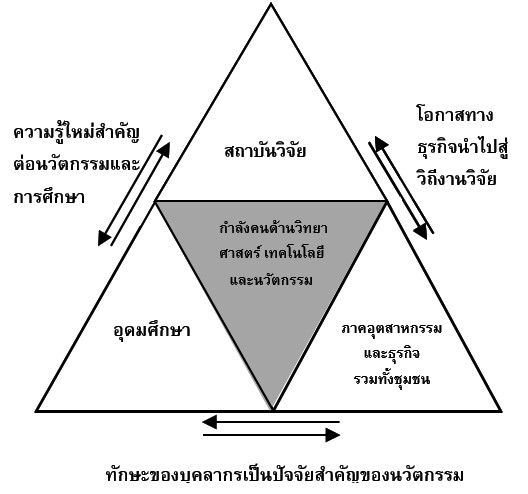มุมมองการเสริมสร้างศักยภาพบุคลากรด้านวิทยาศาสตร์ เทคโนโลยี และนวัตกรรมของไทยสู่การพัฒนาภาคการผลิตและชุมชน
Main Article Content
Abstract
Junpen Meka-apiruk and Orathai Moolkum
รับบทความ: 16 เมษายน 2557; ยอมรับตีพิมพ์: 23 พฤษภาคม 2558
บทคัดย่อ
ประเทศไทยส่งเสริมบุคลากรด้านวิทยาศาสตร์ เทคโนโลยี และนวัตกรรม ซึ่งกำหนดไว้ในแผนระดับชาติ ได้แก่ แผนพัฒนาเศรษฐกิจและสังคมแห่งชาติ และแผนพัฒนาวิทยาศาสตร์ เทคโนโลยีและนวัตกรรมแห่งชาติ อย่างไรก็ตาม จากการจัดอันดับขีดความสามารถในการแข่งขันของประเทศที่มีเศรษฐกิจดีทั่วโลกของสถาบันการจัดการนานาชาติ (International Institute for Management Development, IMD) สมาพันธรัฐสวิส พบว่า ปี พ.ศ. 2556 ขีดความสามารถทางด้านวิทยาศาสตร์และเทคโนโลยีของไทยทางด้านวิทยาศาสตร์อยู่ในลำดับที่ 40 ด้านเทคโนโลยีอยู่ในลำดับที่ 47 และดัชนีการพัฒนาทรัพยากรมนุษย์อยู่ในลำดับที่ 55 พบว่า มีแนวโน้มลดลง จากการวิเคราะห์ข้อมูลทุติยภูมิและการสัมภาษณ์เชิงลึกจากผู้บริหารและผู้ทรงคุณวุฒิที่เกี่ยวข้อง พบว่า สาเหตุของปัญหาความ สามารถลดลง ได้แก่ (1) จำนวนนักวิจัยซึ่งเป็นทุนทางปัญญาในการสร้างองค์ความรู้ใหม่ไม่เพียงพอ (2) ศักยภาพบุคลากรในการผลิตผลงานวิจัยคุณภาพลดลง (3) ความสามารถบุคลากรในการขยายผลงานวิจัยสู่ภาคธุรกิจน้อย และ (4) นักวิจัยและนักวิทยาศาสตร์ขาดแรงจูงใจในการทำงานในสายอาชีพ จากข้อมูลที่สำรวจด้านข้อมูลปฐมภูมิและทุติยภูมิสามารถหาแนวทางการเสริมสร้างศักยภาพบุคลากรด้านวิทยาศาสตร์ เทคโนโลยีและนวัตกรรมของไทย โดยการประยุกต์ใช้แนวปฏิบัติที่ดีจากแผนงาน “ประชาชน” ภายใต้กรอบแผนงานวิจัยฉบับที่ 7 (ค.ศ. 2007–2013) ของสหภาพยุโรปซึ่งเป็นแนวทางนำมาใช้ในบริบทของไทยได้ โดยยึดรูปแบบการพัฒนาบุคลากรด้านวิทยาศาสตร์ เทคโนโลยีและนวัตกรรม เพื่อให้เกิดการหมุนเวียนบุคลากรระหว่างภาคอุดมศึกษา สถาบันวิจัย และอุตสาหกรรมรวมทั้งวิสาหกิจและชุมชน
คำสำคัญ: การพัฒนาศักยภาพบุคลากรด้านวิทยาศาสตร์ ความสามารถในการแข่งขัน การหมุนเวียนบุคลากร
Abstract
Thailand has promoted human resources development on science, technology and innovation as appeared in National Economic and Social Development Plan as well as National Science, Technology and Innovation Development Plan, leading to national strategies. However, International Institute for Management Development (IMD), Switzerland, ranked Thailand on science infrastructure to be 40th in 2013. In addition, Thailand technology infrastructure was ranked to be 36th in 2013. Moreover, Human Development Index was 55th in 2013 showing critical weakness as human capital was crucial for national economic and social development. According to the analysis of secondary data and in–depth interview from the involved executives and experts keen on development of science, technology and innovation, causes of the weakness are as the followings: (1) Number of researchers to create novel body of knowledge were insufficient (2) Personnel capability to perform quality researches was less (3) Personnel competency to extend research results to commercialization was low and (4) Researchers and scientists were scarce of motivation to remain in their career path. If these drawbacks are accumulated and sustained for a long period of time, national competitiveness will be lost. Therefore, success story of “People” in 7th Framework Programme (2007 to 2013) of European Union was analyzed for highly relevant actions. Selected actions were approved by the interviewees for feasible appliance in Thailand. “Proposal for Capacity Building on Science, Technology and Innovation Personnel Development” was created based on the established “Model of Science, Technology and Innovation Personnel Development by Knowledge Triangle Concept” focusing on personnel circulation among higher education, research institutes and industries include enterprises and communities.
Keywords: Capacity building, Brain circulation, Knowledge triangle
Downloads
Article Details

This work is licensed under a Creative Commons Attribution-NonCommercial 4.0 International License.
References
จันทร์เพ็ญ เมฆาอภิรักษ์. (2557) การเสริมสร้างศักยภาพบุคลากรของไทยด้านวิทยาศาสตร์ เทคโนโลยี และนวัตกรรม. รายงานการศึกษาส่วนบุคคลหลักสูตรนักบริหารระดับสูง: ผู้นำที่มีวิสัยทัศน์และคุณธรรม รุ่นที่ 79 วิทยาลัยนักบริหาร สถาบันพัฒนาข้าราชการพลเรือน สำนักงาน ก.พ.
สำนักงานคณะกรรมการนโยบายวิทยาศาสตร์ เทคโนโลยีและนวัตกรรมแห่งชาติ. (2554) นโยบายและแผนวิทยาศาสตร์ เทคโนโลยีและนวัตกรรมแห่งชาติ ฉบับที่ 1 (พ.ศ. 2555–2564). กรุงเทพฯ: กระทรวงวิทยาศาสตร์และเทคโนโลยี.
สำนักงานคณะกรรมการนโยบายวิทยาศาสตร์ เทคโนโลยีและนวัตกรรมแห่งชาติ. (2556) ขีดความสามารถในการแข่งขันของประเทศไทยด้านวิทยาศาสตร์ เทคโนโลยีและนวัตกรรม 2556. STI Review 5: 6.
สำนักงานคณะกรรมการพัฒนาการเศรษฐกิจและสังคมแห่งชาติ. (2554) แผนพัฒนาเศรษฐกิจและสังคมแห่งชาติ ฉบับที่ 11 (พ.ศ. 2555–2559). กรุงเทพฯ: สำนักนายกรัฐมนตรี.
สำนักงานคณะกรรมการวิจัยแห่งชาติ. (2554) นโยบายและยุทธศาสตร์การวิจัยของชาติ ฉบับที่ 8 (พ.ศ. 2555–2559). กรุงเทพฯ: โรงพิมพ์ชุมนุมสหกรณ์การเกษตรแห่งประเทศไทย.
สำนักงานเศรษฐกิจอุตสาหกรรม. (2554) แผนแม่ บทการพัฒนาอุตสาหกรรมไทย พ.ศ. 2555–2574. กรงเทพฯ: กระทรวงอุตสาหกรรม.
อาคม เติมพิทยาไพสิฐ. (2555) ทิศทางและการบริหารจัดการงานวิจัยของประเทศเพื่อประโยชน์เชิงพาณิชย์. การนำเสนอผล งานวิจัยแห่งชาติ 2555 (Thailand Research Expo 2012). กรุงเทพฯ: ศูนย์ประชุมบางกอกคอนเวนชันเซ็นเตอร์.
Buerkler, E. (2013). Critical success factors for joint innovation: Experiences from a New Zealand innovation platform. The Public Sector Innovation Journal 18(2):1–23.
Chitakornkijsil, P. (2010). Perspectives on Entrepreneurship opportunities and internationalization. The International Journal of Organizational Innovation. 3(3): 184–202.
European Commission. (2007a) Work Programme 2007–2008: People. Brussels.
European Commission. (2007b). Work Programme 2008: People. Brussels.
European Commission. (2008a). Communication from Commission to the Council and European Parliament. Better Careers and More Mobility: A European Partnership for Researchers. Brussels.
European Commission. (2008b). Programme 2009: People. Brussels.
European Commission. (2009). 2010 Work Programme: People. Brussels.
European Commission. (2010a). 2011 Work Program: People. Brussels.
European Commission. (2010b). Marie Curie Actions in Brief: A Pocket Guide. Brussels.
European Commission. (2011a). The People Work Programme 2012. Brussels.
European Commission. (2011b) Proposal for a Decision of the European Parliament and of the Council on the Strategic Innovation Agenda of the European Institute of Innovation and Technology (EIT): the Contribution of the EIT to a More Innovative Europe. Brussels.
European Commission. (2012). 2013 Work Programme: People. Brussels.
European Council. (2006). Council Decision of 19 December 2006. Specific Programme ‘People’ Implementing the Seventh Frame work Programme of the European Com-munity for Research, Technological Development and Demonstration Activities (2007 to 2013). Brussels.
European Institute of Innovation and Technology. (2012). Catalysing Innovation in the Knowledge Triangle. Budapest.
European Parliament and of the Council. (2006). Decision of the European Parliament and of the Council of 18 December 2006. The Seventh Framework Programme of the European Community for Research, Technological Development and Demonstration Activities (2007–2013). Brussels.
European Parliament and the Council of the European Union. (2008). Regulation (EC) No 294/2008 of the European Parliament and the Council of 11 March 2008 Establishing the European Institute of Innovation and Technology. Official Journal of the European Union (9.4.2008). L 97. Strasbourg.
IMD. (2013a). IMD World Competitiveness Year book 2013. Lausanne.
IMD. (2013b). World Competitiveness Online 1995 – 2013. Lausanne.
Guion, L., Diehl, D., and McDonald, D. (2011). Conducting an In-depth Interview. University of Florida IFAS Extension. Retrieved from http://edis.ifas.ufl.edu, March 20, 2015.
Lewrick, M., Omar M., and Williams, R. (2011). Market orientation and innovators’ success: An exploration of the influence of customer and competitor orientation” Journal of Technology Management and Innovation 6(3):48–61.
Meho, L. (2006). E–Mail interviewing in qualitative research: A methodological discussion” Journal of the American Society for Information Science and Technology 57(10):1284–1295.
Oinas, P. (2005). Finland: A Success Story? European Planning Studies 13(8): 1227–1244.
Salami, R., and Soltanzadeh, J. (2012). Comparative analysis for science, technology and innovation policy; lessons learned from some selected countries (Brazil, India, China, South Korea and South Africa) for other LdCs like Iran. Journal of Technology Management and Innovation 7(1): 211–226.
Siyanbola, W., Egbetokun, A., Oluseyi, I., Olamade, O., Aderemi, H., and Sanni, M. (2012). Indigenous technologies and innovation in Nigeria: Opportunities for SMEs. American Journal of Industrial and Business Management (2): 64–75.
Scientific and Technological Research Council of Turkey. (2012). EU FP7 People Specific Programme Success Stories Booklet.
